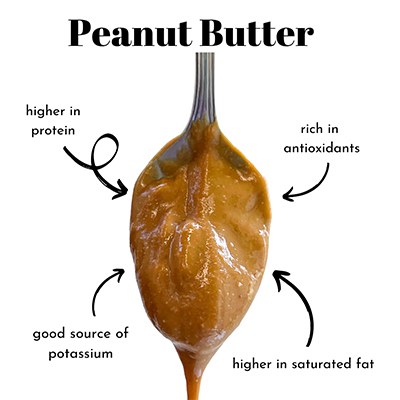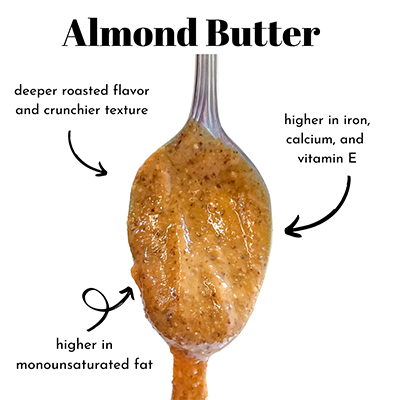May 20, 2021
Almonds and Peanuts and Hazelnuts, Oh My! | A Nut Butter Comparison

Life can be a little nutty at times. Why not embrace it?! We’ve gone nutty with excitement over the launch of our two exhilarating new organic nut butter bars – Almond Butter bar and Hazelnut Butter bar – crafted the Lake Champlain Chocolate way, with only the best organic ingredients and fair trade chocolate.
Nut butters are spreads made by grinding various nuts into a paste-like consistency. Contrary to popular belief, they don’t actually contain any butter. While consumers have enjoyed the original nut butter (peanut butter) for more than a century, alternative versions have been growing in popularity. Today, you’ll find the grocery store shelves lined with a plethora of nut butter options, from almond butter and hazelnut butter to cashew butter and even macadamia nut butter. So, how do you tell the difference between nut butters? How do you know which ones are healthier?
The reality is that not all nuts and nut butters, are created equal. Some offer a better source of protein, while others are higher in Omega-3 fats, and others provide more fiber. We’re here to help you navigate the world of nut butters and learn how to compare the various options.
Which nut butter is the healthiest?
While nut butters can be a great source of plant-based protein, not all nut butters offer the same health benefits. A high-quality nut butter will be made with minimal ingredients; nuts and maybe a touch of salt, that’s it. Many nut butters contain unnecessary amounts of added sugar or artificial sweeteners. High-quality nut butters will often have a layer of oil on top, when you first open the jar. This is completely normal. A good stir and it will incorporate back in. However, sometimes companies will add oils, such as palm oil, to create a nut butter with a smoother consistency that doesn’t separate. Not only is palm oil high in saturated fat, but the production process is often harmful to the environment.

Peanut Butter
Peanut butter is by far the most common and widely available spread. It was first created back in the 1800s and has since become a household staple (thanks to the invention of peanut butter and jelly sandwiches). Peanut butter is not actually a “nut” butter. Peanuts are legumes, which would technically make peanut butter a legume butter, but that doesn’t have quite the same ring to it. While all nut butters are a good source of plant-based protein, peanut butter contains more protein per serving than almond or hazelnut butter. However, peanut butter contains almost twice the amount of saturated fat as almond butter. So, it’s always best to enjoy in moderation.
Peanut butter is also rich in antioxidants. Pair it with dark chocolate, which is also high in antioxidants, and you’ve got yourself a double-dose of free-radical fighting compounds. When it comes to pairings, chocolate and peanut butter are such a timeless combination. Whether it’s a flavor-packed Peanut Five Star Bar®, a classic peanut butter chocolate, or a delight-filled peanut butter egg, this is one duo that our fans can get enough of!

Almond Butter
Over the past decade, almond butter has become increasingly popular. Almond butter can be made from raw or roasted almonds. Because of the higher costs of farming, production, and processing, it’s often more expensive than its counterpart, peanut butter. Both nut butters contain a healthy dose of potassium, biotin, magnesium, and zinc. While a single serving of almond butter has roughly the same number of calories as a serving of peanut butter, almond butter is higher in iron, calcium, and vitamin E — vitamins and minerals that are essential for a healthy heart and strong bones. (Peanut butter contains these vitamins and minerals as well, just not in the same concentration as almond butter.) All nut butters are a good source of fiber. Almond butter contains more fiber than peanut butter and has about 25% more monounsaturated fat, a healthy fat that is said to reduce heart disease and better control blood sugar.
Roasted almond butter has a deeper roasted flavor and crunchier mouth-feel than peanut butter. Pack it in an Almond Five Star Bar® with chunks of roasted almonds and crunchy quinoa, and you’ve got yourself a taste sensation beyond compare! Almond butter often has a more pronounced bitter taste than peanut butter. Pair it with dark chocolate, like in our new Almond Butter bar, and you’ve got a perfectly balanced afternoon treat. The almond butter and dark chocolate combination blend together to form a powerhouse – a trifecta of protein, fiber, and iron – that will give you the energy and focus you need to tackle whatever life throws at you.

Hazelnut Butter
The traditional hazelnut butter spread you love is often loaded with cocoa, sugar, and palm oil. High-quality hazelnut butter, like the one we use in our new Hazelnut Butter bar, is made from ground hazelnuts, and nothing else! These hazelnuts are ethically sourced from Spain, where farmers work under fair labor practices. Of all the nut butters, hazelnut typically has the creamiest texture. While it usually has fewer calories, it contains a higher amount of fat than peanut butter and almond butter. Per serving, it contains less calcium than peanut or almond butter, and is rich in vitamin E and magnesium.
Hazelnut’s indulgent flavor makes it the perfect pairing for a decadent chocolate treat. While this straight hazelnut butter isn’t widely found in the United States, it’s quite popular in European confections, where they blend it with milk chocolate to form gianduja. For our new Hazelnut Butter bar, we blend it with organic dark chocolate, to create a luxurious, vegan-friendly treat that is 100% plant-based.
Comparing nut butters illustrates just how different (and alike) they can be. These spreads can be a great source of plant-based protein, but they should be eaten in moderation. Whether it’s made with peanuts, almonds, or hazelnuts, nut butters contain a healthy dose of fiber, potassium, biotin, magnesium, and zinc. Some have more calories and fat, while others can be creamier in texture or richer in flavor. No matter the nut, peanut butter, almond butter, and hazelnut butter, pair perfectly with chocolate to create a taste sensation that satisfies every mood!